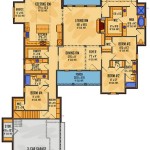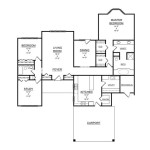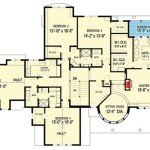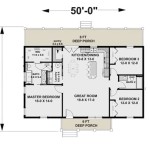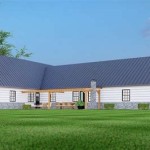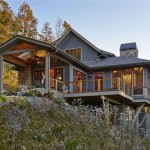Floor Plans with Indoor Pool: Design Considerations and Benefits
The integration of an indoor pool into a residential floor plan represents a significant architectural and engineering undertaking that offers a range of benefits. Such projects require careful planning and consideration of various factors, including space allocation, environmental control, and structural integrity. This article explores the key aspects of designing floor plans that incorporate indoor pools, highlighting the advantages and challenges involved.
Indoor pools are more than just recreational amenities; they can contribute to an enhanced lifestyle, providing year-round access for exercise, relaxation, and social gatherings. Furthermore, they add a distinct element of luxury and sophistication to a property, potentially increasing its market value. However, the design and construction of such facilities demand specialized expertise to ensure functionality, longevity, and occupant comfort.
Space Allocation and Layout Optimization
The placement of the indoor pool within the overall floor plan is a critical decision influencing both aesthetics and practicality. Several layout options exist, each with its own set of advantages and drawbacks. A common approach is to situate the pool in a dedicated wing or extension of the main house, allowing for a degree of separation from living areas. This can help mitigate noise and humidity transfer, while also providing a distinct, private space.
Alternatively, the pool can be integrated more directly into the core of the house, creating a central focal point. This arrangement can enhance the visual appeal of the property and facilitate easy access from various rooms. However, it necessitates careful management of environmental factors to prevent moisture damage and maintain comfortable living conditions throughout the rest of the home. The size and shape of the pool are also important considerations, as they directly impact the amount of space required and the flow of traffic within the pool area. A rectangular pool is often the most practical shape for swimming laps, while freeform designs can create a more natural and aesthetically pleasing environment.
Beyond the pool itself, the surrounding area should be thoughtfully planned to accommodate various activities. This may include provisions for seating, lounging, dining, and changing. Sufficient space for circulation is also essential to ensure easy movement around the pool. The pool area should be designed to be both functional and visually appealing, reflecting the overall style and character of the house. Careful consideration should be given to the selection of materials, finishes, and lighting to create a cohesive and inviting atmosphere. The integration of natural light through skylights or large windows can enhance the sense of spaciousness and connection to the outdoors.
Environmental Control and Structural Considerations
Maintaining a comfortable and healthy environment within the indoor pool area is essential to prevent moisture-related problems and ensure occupant well-being. Effective ventilation, dehumidification, and temperature control are crucial components of the environmental control system. The selection of appropriate materials that are resistant to moisture and chlorine exposure is also vital to prevent corrosion and deterioration.
Ventilation systems play a key role in removing excess humidity from the air, preventing condensation on surfaces, and reducing the risk of mold growth. Dehumidifiers further reduce humidity levels, ensuring a comfortable and healthy environment. The size and capacity of these systems should be carefully calculated based on the size of the pool, the water temperature, and the expected level of usage. Heating systems are needed to maintain a comfortable air temperature in the pool area, as well as to heat the pool water. Energy-efficient options, such as solar heating or heat pumps, can help to reduce operating costs and minimize environmental impact.
The structural design of the pool area must address the weight of the water and the potential for water leakage. Proper waterproofing is essential to prevent water damage to surrounding structures. The foundation and walls of the pool area should be designed to withstand the hydrostatic pressure exerted by the water. Materials used in the construction of the pool should be durable, resistant to chemicals, and easy to clean. Tile is a popular choice for pool surfaces, as it is both aesthetically pleasing and resistant to moisture. However, other options, such as fiberglass or vinyl liners, may also be considered. The design of the pool area should also take into account accessibility for maintenance and repairs. Adequate space should be provided for accessing plumbing, electrical, and mechanical systems.
Material Selection and Aesthetic Design
The selection of materials and finishes for the indoor pool area is a crucial aspect of the overall design, influencing both aesthetics and functionality. Materials should be chosen for their durability, resistance to moisture and chemicals, and ease of maintenance. The aesthetic design should complement the overall style of the house, creating a cohesive and inviting atmosphere.
For flooring, non-slip surfaces are essential to prevent accidents. Options include textured tile, stone, or specialized pool deck coatings. Walls can be finished with tile, stone, or paint that is specifically formulated for use in humid environments. Ceilings should be constructed from materials that are resistant to moisture and mold growth, such as painted drywall or suspended ceiling panels. Lighting plays a vital role in setting the mood and enhancing the functionality of the pool area. Natural light should be maximized through the use of skylights or large windows. Artificial lighting should be carefully planned to provide adequate illumination for swimming and other activities, while also creating a relaxing and inviting atmosphere.
The incorporation of landscaping and greenery can enhance the natural feel of the indoor pool area, creating a more relaxing and inviting environment. Potted plants, vertical gardens, or even small water features can add a touch of nature to the space. The overall design of the indoor pool area should be carefully considered to create a space that is both functional and aesthetically pleasing. The pool should be designed to be a welcoming and enjoyable space for all users, regardless of their age or ability. This may involve incorporating features such as ramps, handrails, or shallow entry points to ensure accessibility for people with disabilities.
The design of the indoor pool area should also take into account the potential for noise transmission. The sound of splashing water can be amplified in an enclosed space, potentially disturbing residents in other parts of the house. Soundproofing materials, such as acoustic panels or insulated walls, can help to reduce noise levels. Furthermore, the use of quieter pool equipment, such as variable-speed pumps, can minimize noise pollution. By carefully considering these factors, it is possible to create an indoor pool area that is both functional and aesthetically pleasing, providing a valuable amenity for the homeowner.

Luxury French Country Home Plan With Courtyard And Indoor Pool 290110iy Architectural Designs House Plans

Striking Home Plan With Indoor Pool 72402da Architectural Designs House Plans

Indoor Pool House Mansion Floor Plan Plans

House Plans With Pools Luxury Home Floor Swimming

Contemporary Style House Plan 2 Beds 3 Baths 2283 Sq Ft 60 763 Shed Plans Indoor Pool

Indoor Swimming Pools House Plans And More

House Plans With Pools Luxury Home Floor Swimming

2 Story Modern Home Plan With Indoor Pool 85270ms Architectural Designs House Plans

Indoor Swimming Pool And Jacuzzi Area Free Design 3d House Ideas Marina G By Planner 5d

House Plan 4 Bedrooms 3 5 Bathrooms Garage 2851 Drummond Plans


